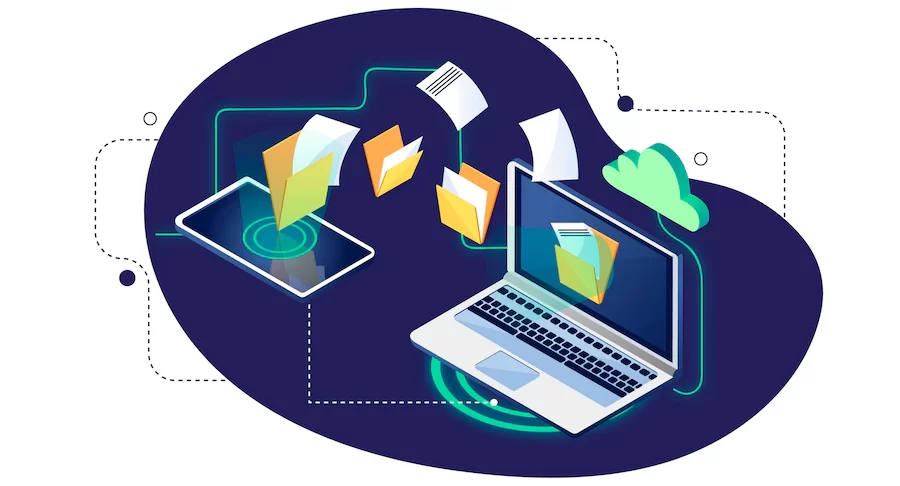8 Best Practices for Secure File Sharing
- 1 8 Best Practices for Secure File Sharing
- 1.1 Minimize the use of USBs.
- 1.2 Use VPNs
- 1.3 Create strong passwords
- 1.4 Take advantage of cloud-based solutions.
- 1.5 Make sure your team knows how to share files securely.
- 1.6 Do not share files via email.
- 1.7 Put a format for archives in place.
- 1.8 Be careful when clicking on links.
- 2 Final Words
In the age of technology, virtually every aspect of our daily lives depends on it. So, it is no surprise that it has become crucial for businesses to share information and data on time to thrive. For tasks to be completed effectively and conveniently, an organization’s teams must have the correct information. It’s for this reason that businesses rely heavily on file sharing.
In recent years, technological advancements have made it easier to share files. However, with technological advancement, the risk of bad guys exploiting vulnerabilities in the system also increases. Without a secure file-sharing practice, an organization can suffer significant damage. Furthermore, file-sharing without security makes the system susceptible to a man-in-the-middle attack or malware installation. To mitigate the growing risks associated with file-sharing vulnerabilities, organizations must prioritize implementing secure solutions like GoAnywhere. If you use GoAnywhere, you can establish a robust file-sharing framework that effectively mitigates the potential dangers, ensuring the confidentiality and integrity of your data.
8 Best Practices for Secure File Sharing
So, to keep your business files safe and secure during sharing, follow these practices.
Minimize the use of USBs.
The use of USBs as a means of transferring files is prevalent. The only way to ensure USBs’ security is to avoid losing them. Do you know precisely how many USBs are lying around in your neighbourhood? That’s how easily one can be lost. Sadly, if the USB gets lost, you won’t know where it will end up or in whose hands. A malicious person can easily access and misuse the data or information if they get their hands on it. Therefore, to prevent file-sharing problems, it is best to avoid using USBs in the first place, and if you must use them, keep them safe at all times.
Use VPNs
As flexible working becomes more popular, employees no longer have to be confined to the office. Employees who elect to work in public places are more likely to use insecure public networks. Remote workers can’t control where they work, but you can educate them about connecting to these networks via a VPN.
Using a VPN, you can transfer data securely over the internet. By doing this, hackers cannot access what’s being moved. Moreover, VPNs come in handy when sending large videos or other files. The file size can be hidden from your ISP using a VPN.
Create strong passwords
Using a file-sharing solution with password protection is something you should discuss with your team. Data security cannot be ensured if your passwords are easy to guess and simple. By using strong passwords, you can prevent unauthorized people from accessing your files. Likewise, make the password long enough to ensure security by using various upper- and lower-case letters, symbols, and numbers. It would be best to use multi-factor authentication to ensure that only authorized individuals can access the files. You may also use something the user can only access, such as texting their mobile phone to access data.
Take advantage of cloud-based solutions.
File-sharing solutions provide a secure platform for storing files and allowing access from anywhere. Therefore, sharing files between users is no longer necessary. Depending on your permission settings, you can restrict access to these files. Your permissions are entirely under your control, and you will be notified if anyone violates them. As a result, you can easily control who has access to the files and who can make changes to them. Additionally, the information remains encrypted, enhancing its security.
Make sure your team knows how to share files securely.
It can be easy to neglect secure file-sharing practices due to busy schedules and overwhelming pressure to deliver. Nevertheless, mistakes of this kind can be costly. Educate your team about secure file sharing so that such events don’t happen. Make sure they understand the consequences of mishandling the information. Your organization can classify data and explain the level of security needed for each class.
You also need to ensure the entire team is well-trained in using the file-sharing software. When this is not done, employees will rely on their knowledge, which is unlikely to align with your organization’s secure file-sharing policy.
Do not share files via email.
Email scams and phishing attempts are becoming increasingly widespread, and they can result in losing files that won’t reach the intended recipient.
Hackers often look in their victims’ emails to find sensitive information. Since most people have weak email passwords, cybercriminals can easily hack their emails. Furthermore, they use email phishing to spread infected links as files to their ignorant victims. They fall into their traps immediately after the user clicks the link or downloads the file.
To prevent your organization from becoming a victim of this scam, encourage your employees not to send or receive files via email. The company should implement a file-sharing program that its employees can only access.
Put a format for archives in place.
The archive file format stacks one or more files with metadata. You can combine multiple data files into a single archive file. To easily access and store various data files, you can combine them into a single archive file. In addition, you can compress files to reduce their size on your computer and the amount of space they take up.
By archiving your data, you prevent leaks and exposure to such information. When multiple files are included in an archive file, scammers will have difficulty identifying a particular file.
Be careful when clicking on links.
Double-checking links before clicking on them is another highly effective file-sharing security practice. Despite its simplicity, neglecting it could result in significant data loss.
Teach your coworkers and employees the importance of this simple business activity to cultivate business etiquette. Closely inspecting links before clicking on them can prevent hacking and hijacking of networks. By masking links with dubious links, a hacker can easily take over your business files or even your login credentials.
Final Words
File sharing is an essential part of collaboration. If two or more people work together, they need to share files, especially if they are located at different locations. In any case, it’s their duty to protect their files. To avoid malicious cybercriminals, you must cultivate safe practices when sharing files.


















